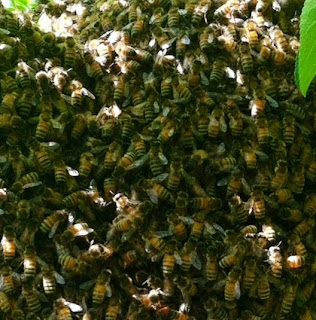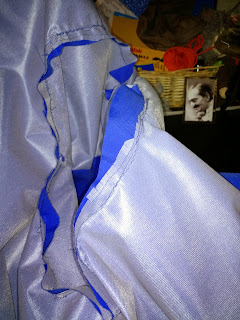For years, I have carried a silnylon poncho with me for rain gear when I hike or backpack. Most of the time, it has been more than enough, particularly given that I live in the Southwest, and we have been having a drought lately.
Last year, my son and I headed into the Pecos Wilderness for what was supposed to be a three or four day trip. The day was already clouding up in the morning, and lightning was ricocheting around when we reached the place we were going to camp. We set up the tent and also rigged up the 6' by 8' tarp I had. Almost as soon as we were set up, around noon I believe, it began to hail. It hailed and hailed and hailed. A small river began to run beneath us where we were huddled underneath the tarp with our puppy Jess. The wind kept whipping the poncho around, and the great wings of cloth kept getting in my way as I tried to shift things around and get the stove going. We soon had to abandon the tarp and huddle in the tent. Being a little claustrophobic, I'm not a big fan of tents. It rained for about four hours that afternoon. We had a two hour break, which we used for making dinner and wandering about the area, and then it rained all night. We had hoped to get up Santa Fe Baldy the next day, but it looked like the rain was going to keep up, my son was woefully unprepared for rain, and I had reached the limits of my patience with the poncho, so we headed back out of the wilderness. That week ended up being the stormiest week of the whole summer.
I'm planning an eight day backpacking trip this July. July is typically the rainy season. I've been overhauling my gear this spring. Most of what I use is left over from my time managing the Wilderness Exchange, a wonderful backpacking shop in Santa Fe that was open from the late eighties to the mid-nineties. I finally ordered a
Giant Jensen from Rivendell Mountain Works. I became familiar with Rivendell Mountain Works when they were mentioned by Rivendell Bicycle Works, probably in a Rivendell reader. The Jensen is a soft pack designed by Don Jensen in the late sixties. Some people really love them. Some people don't. I've always wanted to try one, and my wife usually uses my Osprey when we backpack together. My frame pack is having some problems right now. May 21st was my birthday. I thought it was about time to give the Jensen a shot.
While on their page, I noticed that they have also finally put their
cagoules into production. I thought that would be just the right thing for a week long mountain storm. (I did another two-week trip in the early nineties with nothing but a Sierra Designs Microlight jacket. I was soaked to the skin the entire time). I've never tried a cagoule. They look like they might be too hot, but I have my 60/40 parka for hiking in. I would just use the cagoule if it was really, persistently rainy.
However, there are a lot of things I want to buy this spring, and I'm on a limited budget. I've been rereading my copy of Ray Jardine's
Beyond Backpacking, and he has a chapter on making your own gear. I have a sewing machine, and occasionally, I get excited about using it. I ordered some materials to make a larger silnylon rainfly, a sleeping quilt (I have a 20 year old down bag that is beginning to lose some of its loft), and finally, a pattern for a cagoule from
the Rain Shed. I also ordered some Xalt waterproof breathable fabric from them along with all the other bits of things I would need.
I decided to go ahead and do it because the idea of making my own cagoule frightened me a little. I tend to be a perfectionist, and I get irritated when I have to struggle with things. Sewing is just the kind of challenge I need. Before I go any further, I have to say that this project is not so much to save money - at just under $100, it's almost a third the cost of the Rivendell cagoule, but I could have picked some waterproof breathable jacket up from Sierra Trading Post or Campmor for less. I really wanted to meet the challenge and make some of my own gear. And I also was fixated on the idea of a cagoule. There aren't many choices out there.
The thing is, I am not an experienced sewer. I can sew, but it's a little like the first time you drive a car. I step on the little pedal, and it's like "Whoa, hey, hey, hey!" I end up with stitching that careens all over the place.
The cagoule pattern, thankfully, is pretty simple. I'm most of the way done. It's basically like a poncho with the extra fabric beneath the arms cut out and sewn together, an extension, and a pocket sewn on the front. The pocket took a lot of time, and I think I did a pretty damn good job on the pocket. I was using one of those little wheel cutters to cut out the fabric. I found it difficult to cut the pattern out exactly. In the same way my stitching generally resembles a little syne wave, my cutting with the rotary cutter also tended to weave in and out. I am not sure the rotary cutter is best.
With the hood, particularly cutting the hole for the hood, I believe I would have been better off tracing the pattern with chalk and cutting it out with scissors. The hood has been the most difficult part of the project so far. It takes three layers of facing, and it was a struggle getting all those edges matched up. I managed fairly well, but I have some wonky stitching it there. I made two button holes for the drawcord. I've never made button holes before, and I enjoyed learning how, but I cut through the stitching of one with my seam ripper when I was trying to cut out the middle of the hole. I fixed that with a little extra bar tacking. I noticed that the other buttonhole is missing some of its boundary, and all of the facing is together now, so I can't fix it, at least not properly. I think I may have nicked that thread too, and it's losing some of its stitching. In general, though, I think it will hold up.
Cutting out the hole for the hood was a mess. I tried to run the rotary cutter around the pattern, and at one point, it slipped off to the side about a quarter of an inch. Also, my first time around, I did not cut all the way through the fabric all the way around, so I had to try to connect my incisions. Instead of a smooth oval-like shape, I ended up with a slightly raggedy looking oval-like shape. If I ever do this again, I will use scissors.
I did the staystitching and made the clips dictated by the pattern, but I'm still not sure why I did those things or if I did them right. The instructions say the staystitch is inside the seam allowance, but I was not sure how far inside, so sometimes it's almost at the edge and sometimes it's further away.
I pinned the hood and the body of the cagoule together as well as I could and tried to stitch around the seam. Twice I ended up sewing a fold of fabric into the seam and had to get out the seam ripper and start over. I'm going to have to do a lot of seam sealing in there.
I believe some sewing machines have an arm that you can place things like sleeves and hoods over, but my sewing machine just has a flat surface, and it's very nerve wracking trying to go around like that, paying attention to the seam allowance and to the bunching of the fabric around the area you are sewing. I'm sure it's the type of thing that gets easier with practice, but when do you practice sewing hoods onto raincoats?
In the end, my edges didn't really meet up all that well. The hood has a little tongue of fabric left over that juts out past the seam. I did one seam, with everything pinned in place, and then I did another zigzag stitch which was supposed to be near the first stitch, but it ended up meandering all over the place. With the zigzag stitch, and all the stitching I had to rip out with the seam ripper and start again on to of where it left off, the seam for the hood looks like it was sewn by a spider on LSD.
Luckily, when you turn it rightside out, it looks fine. I'm also pretty certain that once I have seam sealed the area, it will be watertight. The perfectionist in me wants it to be pretty. Maybe I should do a little trimming -- or maybe I should leave well enough alone.
At this point, I realized that I was really tired, and even though the remaining steps seem pretty simple and straightforward, I've put it aside until I am a little better rested. I have a bad tendency to want to finish whatever I start without taking a break. I had planned to do a little on this project at a time, aiming to finish in two or three weeks. Instead, I got caught up in the magic of having a three dimensional object arise out of two dimensional cloth and kept going far past the point I should have stopped.
When I finish, I will post a nice, right-side out photo.










